Carel Fabritius
- baptized 27 February, 1622–died 12 October, 1654
- active in Delft c. 1650–1654
In his youth, Carel Fabritius worked as a carpenter—his name Fabritius may have been derived from the Latin "faber" from this profession. In the early 1640s, he became an apprentice to the great Rembrandt van Rijn in Amsterdam. By 1650, he was living in Delft, where, in 1652, he joined the Guild of Saint Luke. The art of Vermeer has been connected to that of Fabritius due to stylistic affinities and to a poem by the Delft publisher Arnold BonArnold Bon, a member of the printers' guild since 1651, served as the official printer for the city council of Delft from around 1660 to about 1690. He resided on the north side of the Markt in a house originally named Montfoort, later known as "Vinder van de Druckkonst" (Inventor of Printing). He is notable for publishing the renowned book Beschryvinge der stadt Delf by Dirck van Bleyswijck, with part I released in 1667 and part II in 1680. Bon was also a minor poet, and in 1652, he published a collection of his own writings, primarily Dutch poems and popular songs, including the Mopsjes,which were light-hearted and mischievous despite his claim that they aimed to discourage lustful love practices. (before 1634–1691) printed in Dirk van Bleyswijck's Beschryvinge der stad Delft (A Description of Delft, 1689) which laments Fabritius' death in the infamous Delft thunderclap but rejoices Vermeer's "rise" (fig. 1).
Thus did this Phoenix, to our loss, expire,
In the midst, and at the height of his career,
But fortunately there arose from his fire,
VERMEER who masterfully trod his path.
 fig. 1 Dirck van Bleyswijck, Beschryvinge der Stadt Delft (Delft, 1667), 854.
fig. 1 Dirck van Bleyswijck, Beschryvinge der Stadt Delft (Delft, 1667), 854.Although early art historians interpreted the four ambiguous lines of Bon's laudatory poem as suggesting that Vermeer studied under Fabritius, Fabritius joined the Delft guild only fourteen months before Vermeer, and traces of Fabritius's style do not appear in Vermeer's work until several years after Fabritius's death. Nonetheless, that Vermeer was familiar with Fabritius' work is demonstrated by the fact that he had a number of Fabritius' tronies listed in his possession as attested in the 1675 probate inventory of Vermeer's estate. Documents indicate that Fabritius had been active as a portraitist from the late 1640s until his untimely death.
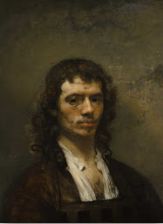 fig. 1 Self Portrait
fig. 1 Self PortraitCarel Fabritius
1654
Oil on panel, 65 x 49 cm.
Museum Boijmans Van Beuningen, Rotterdam
The reputation of Fabritius in his own time was considerable. Van Bleyswijck wrote he was "an excellent and outstanding painter who was so skilled and unerring in the manner of 'perspectives' as well as naturalistic coloring and the handling of his paint that (in the opinion of many connoisseurs of art) he never had an equal." Taking to heart Rembrandt's dictum, "follow nature," Fabritius experimented with a variety of innovative formats in his attempts to create the most vivid an illusion of reality possible. He made trompe-l'œil wall paintings that amazed Delft art lovers for making "a small room seem very large…bonding beautifully with the place for which they are made." He also created murals, described by the owner as being "nailed fast" to the wall, in the Delft brewery called "The World Upside Down." However, none of Fabritius' wall paintings have survived. Another document refers to a "piece by Fabritius being in a case [or box]," though it is unclear whether the object was a perspective box (also called a "peepshow," like those made by Samuel van Hoogstraten), or a picture housed in a small box with doors on the front. Such boxes were occasionally used to shield particularly precious paintings from dust and, perhaps, surprise the viewer when the doors were opened to expose the illusionist picture within.
In Delft, the style of Fabritius changed dramatically, but since few works from the years immediately preceding his arrival have survived, there is no way of knowing what may have motivated him to change artistic course. It is likewise impossible to evaluate exactly what impact he had on his colleagues since a sizable part of his work perished with him in the Delft Thunderclap—only four paintings survive from his Delft period. The art historian and de Hooch expert Peter Sutton warns that the artist's reputation as the "fountainhead" of the School of Delft is largely based on the presumed qualities of his paintings. "His achievements," writes Sutton, "were brilliant, but not isolated."Peter C. Sutton, Pieter De Hoogh: Complete Edition (Oxford: Oxford University Press, 1980), 18.
Although the art historian Christopher Brown likewise cautions against designating Fabritius (in the words of Sutton)Peter C. Sutton, Pieter De Hoogh: Complete Edition (Oxford: Oxford University Press, 1980), 24 as "an essential catalyst" of the School of Delft, he holds that the artist was not merely an "isolated figure, a brilliant, experimental artist." "A common interest in daylight effects and in the expressive possibilities of the use of space [in Delft painting] may seem a vague, even evasive, way in which to define Fabritius' relationship with his contemporaries, but the relationship was a real one and it was in these essentially technical matters that it resided."Christopher Brown, Carel Fabritius: Complete Edition (Ithaca: Cornell University Press, 1981).
Carel Fabritius
Oil on canvas, 15.5 x 31.7 cm.
National Gallery, London
Fabritius' reputation as a master of perspective has induced some art historians to speculate that he was responsible for stimulating Gerard Houckgeest's and Emanuel de Witte's experiments in architectural painting. However, Houckgeest had been painting church interiors with elaborate perspectives for many years.
Three genre paintings made by Fabritius while he lived in Delft have survived: the View of Delft (fig. 2), The Goldfinch (fig. 3), and The Sentry (fig.4) Each one of them displays an extraordinary clear light and atmospheric tone, breaking from the heavy chiaroscuro modeling that Fabritius had adopted in his earlier large-scale Biblical paintings, influenced by Rembrandt.
The View of Delft, a tiny picture which measures a mere 15.4 x 31.6 cm., is an anamorphic, wide-angled view which shows a music stall in the foreground and the Nieuwe Kerk (New Church) of Delft and a side street in the background on a luminous Delft afternoon. In the foreground, a brooding street merchant sits behind his wares, a lute and a bass viol. It is probable that the painting was created for viewing in a cylindrical perspective box, where its evident distortions would disappear when seen through a single peephole.An anamorphic painting is a unique form of art that distorts its subject using unusual perspectives or optical illusions, which can only be viewed as intended from a specific angle or through a special device. This technique deliberately warps the image, making it appear abstract or unrecognizable at first glance. However, when viewed from the correct angle or through an accompanying device like a cylindrical mirror or a viewing lens, the distorted image suddenly aligns and the true picture emerges clearly. Anamorphic art plays with perception, challenging the viewer to engage with the artwork in a more dynamic way, and often serves as a clever demonstration of artistic skill and optical science. It is considered the first street view to have been painted in Delft. The painting was made in 1652, less than two years after the son of Willem the Silent, the father of the Dutch nationhad, died and been buried in Delft's Nieuwe Kerk, the church at the center of the painting. There is speculation that the painting may have a connection to the early death of Willem II.
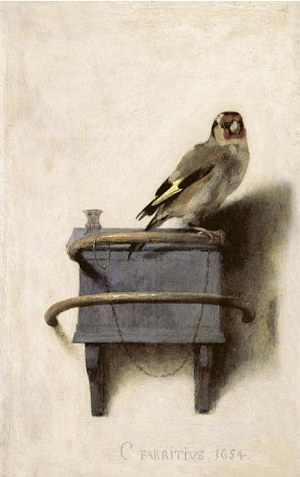 fig. 3 The Goldfinch
fig. 3 The GoldfinchCarel Fabritius
1654
Oil on panel, 33.5 x 22.8 cm.
Mauritshuis, The Hague
 fig. 4 The Sentry
fig. 4 The SentryCarel Fabritius
1654
Oil on canvas, 68 cm × 58 cm.
Staatliches Museum Schwerin, Schwerin, Germany
The two genre pieces, The Goldfinch, and The Sentry, feature unconventional light gray backgrounds, which many critics believe inspired the white-washed walls in Vermeer's and de Hooch's works (see Vermeer's Woman with a Pearl Necklace). In 1675, several of Fabritius' paintings, which Vermeer and other painters of the time traded in alongside their own works, were listed in a probate inventory of mobile goods compiled after Vermeer's death.
 fig. 5 Dead Partridge Hanging from a Nail
fig. 5 Dead Partridge Hanging from a NailJan Baptist Weenix
1651
Oil on canvas, 50.6 x 43.5 cm.
Mauritshuis, The Hague
The panel features an unpretentious goldfinch,In the 17th century Netherlands, the goldfinch was laden with rich symbolic significance, deeply interwoven into the fabric of religious, moral, and artistic expression of the time. Often represented in paintings, it was emblematic of the Passion of Christ. . Beyond its Christian symbolism, the goldfinch represented the human soul, its capacity for flight serving as a metaphor for spiritual ascension. In the realm of vanitas art, it underscored the transient nature of life, juxtaposing its vibrant plumage against the themes of mortality and the ephemeral. The bird also conveyed moral lessons, embodying resilience and the ability to find sustenance in adversity, much like its habit of feeding on thistles. Additionally, as a popular pet, the goldfinch reflected domestic joy and status, showcasing an appreciation for nature and the finer aspects of domestic life. Through these multifaceted symbols, the goldfinch in Dutch Golden Age art transcended its role as a mere subject, embodying complex layers of meaning and reflection. tethered by a delicate metal chain, set against a rough white-washed wall. The painting, one of his most eloquent and powerful works despite in its simplicity and small dimensions, may have inspired other works by Dutch still life painters. But Fabritius' picture is no still life. A series of quick brush strokes evoke the pet's downy body, which seems alive. Ready to flit away in an instant if not mercilessly chained in order to divert people passing by.
By comparison, Jan Baptist Weenix's (1621–c. 1659) use of the motif of a dead partridge (fig. 5) appears lost in minute details. Since Fabritius' small panel has mitered corners and nail holes on its vertical edges, some scholars have argued that the panel may once have been a door on a wooden box or case that encased another painting behind it.
- Brown, Christopher. Carel Fabritius with a Catalogue Raisonné. Oxford: Phaidon, 1981.
- Duparc, Frederik J., Gero Seelig, and Ariane Van Suchtelen. Carel Fabritius 1622–1654. The Hague: Royal Cabinet of Paintings, Mauritshuis, 2004.
- Franits, Wayne. Pieter de Hooch: A Woman Preparing Bread and Butter for a Boy. Getty Museum Studies on Art. Los Angeles: Getty Museum, 2006.
- Jantzen, Hans. Das niederländische Architekturbild. 2nd ed. Brunswick, 1979. First published 1910, Leipzig.
- Liedtke, Walter A. A View of Delft: Vermeer and his Contemporaries. Zwolle: Waanders Publications, 2000.
- Liedtke, Walter A., Michiel Plomp, and Axel Rüger. Vermeer and the Delft School. New York: Metropolitan Museum of Art, 2001.
- Liedtke, Walter. Architectural Painting in Delft: Gerard Houckgeest, Hendrick Van Vliet, Emanuel De Witte. Doornspijk: Davaco, 1982.
- Liedtke, Walter A. "De Witte and Houckgeest: Two New Paintings from Their Years in Delft." The Burlington Magazine 128, no. 1004 (Nov. 1986): 802–805.
- Lokin, Danielle, and Michiel C. Kersten. "The Delft Church Interior." In Delft Masters, Vermeer's Contemporaries. Zwolle: Waanders Publications, 1996, 41–86.
- Manke, Ilse Ruth. Emanuel De Witte: 1617–1622. Amsterdam: Hertzberger, 1963.
- Michalski, Sergiusz. "Rembrandt and the Church Interiors of the Delft School." Artibus et Historiae 23, no. 46 (2002): 183–193.
- Schwartz, Gary. "With Emanuel de Witte in the Oude Kerk in Amsterdam." In Geest en gratie: Essays Presented to Ildiko Ember on Her Seventieth Birthday, edited by Orsolya Radványi, 84–91. 2001.
- Sutton, Peter C. Pieter De Hoogh: Complete Edition. Oxford: Phaidon, 1980.
- Walsh, Amy L. Paulus Potter: His Works and Their Meaning. Ann Arbor: Columbia University, 1989.
- Wheelock, Arthur K., Jr. "Gerard Houckgeest and Emmanuel de Witte: Architectural Painting in Delft around 1650." Simiolus 8 (1975/76): 167–185.
The works of Fabritius feature dazzling brushwork and paint applications, ranging from the thinnest veils of fluid paint to crusty white impasto, a legacy of Rembrandt. His brushwork is delicate and precise, yet not linear, with his contours subtly blurred. Judging from his few surviving paintings, he also possessed an acute sense of how the tone and texture of paint affects spatial reading.Christopher Brown, Carel Fabritius: Complete Edition (Ithaca: Cornell University Press, 1981).
Fabritius died at the young age of 32 on 12 October 1654, when thirty tons of gunpowder stored in barrels in a magazine in a former Delft convent ignited as a keeper opened the store for inspection, called the Delft Donderslag (The Delft Thunderclap), destroying a quarter of the city. The artist's studio, along with many of his paintings, was demolished. Fabritius perished alongside his student Mattias Spoors and a church deacon, Simon Decker, all of whom were working together on a painting at the time.
Despite his exceedingly small oeuvre, Fabritius is counted among the most illustrious painters of seventeenth-century Holland. Of the twelve or so surviving pictures attributed to him, eight may be considered masterpieces.
CAREL FABRITIUS IN HIGH-RESOLUTION
While viewing works of art in person is irreplaceable, today's high-resolution digital images offer a compelling alternative. These digital representations, which far surpass traditional printed images in both color and detail, offer a valid means for appreciating art. Below, you'll find a curated collection of high-quality digital images showcasing the paintings of Carel Fabritius that are readily accessible online.
The View of Delft (1652)
http://www.nationalgallery.org.uk/paintings/carel-fabritius-a-view-of-delft
Young Man in a Fur Cap (1654)
http://www.nationalgallery.org.uk/paintings/carel-fabritius-young-man-in-a-fur-cap
Self-Portrait (c. 1645)
http://www.google.com/culturalinstitute/entity/%2Fm%2F029vlc?projectId=art-project
The Goldfinch (1654)
http://www.geheugenvannederland.nl/?/en/items/MAU01:0605/&p=1&i=10
&t=27&st=carel%20fabritius&sc=%28cql.serverChoice%20all%20carel%2
0%20AND%20fabritius%29/&wst=carel%20fabritius
Paulus Potter
- born 1625, died 1654 Amsterdam
- active in Delft from 1646 (or earlier)–1649?
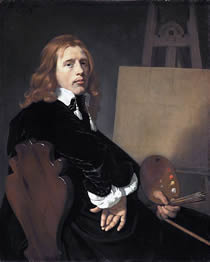 fig. 6 Portrait of Paulus Potter
fig. 6 Portrait of Paulus PotterBartholomeus van der Helst
1654
Oil on canvas, 99 × 80 cm.
Mauritshuis, The Hague
Paulus Potter (fig. 6) was a precocious artist. His earliest works date from 1640, when he would have been 15 years old. Few details are known about his life.
Potter was one of the first artists to paint "portraits" of animals (fig. 7 & 8) , not just backdrops for human action. He entered Delft's Guild of Saint Luke in 1646 and later moved to The Hague, where he resided next to the successful landscape painter Jan van Goyen. Potter's success in The Hague lay in his ability to represent an idealized view of country life in a previously unseen naturalistic mode
Potter is known to have wandered the Dutch countryside with a sketchbook, observing the behavior of farm animals at different times of day and capturing the nuances of light from morning to dusk. Few of his contemporaries were as attuned to nature's moods or to the timeless harmony of beasts, landscape, and weather. While undoubtedly familiar with landscape traditions, Potter introduced a cooler, silvery tonality in his works of the late 1640s. He sometimes grouped foreground figures together in shadow, creating a silhouette effect that stands out suggestively against the atmospheric background landscape. Potter may be compared with Vermeer in this respect: he would learn a great deal from other painters, see what they had seen, and then look again at nature, judging for himself.Peter C. Sutton, Pieter De Hoogh: Complete Edition (Oxford: Oxford University Press, 1980), 18.
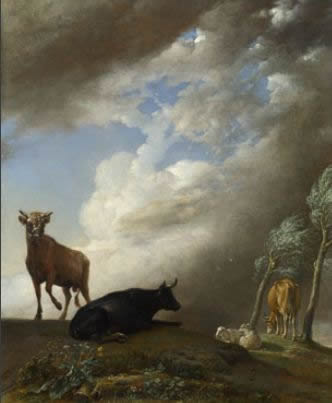
fig. 7 Cattle and Sheep in a Stormy Landscape
Paulus Potter
1647
Oil on oak, 46.3 x 37.8 cm.
National Gallery, London
Although Potter was the most talented landscape painter ever to work in Delft, other landscapists in the first half of the century who also worked in Delft were Jacob van Geel (c. 1585–not before 1638), Willem van den Bundel, and Pieter Groenewegen (1590/1600–1658; one of Groenewegen's works appears in the background of Vermeer's Guitar Player). Despite the small size of many of his compositions, Potter was able to confer an impression of monumentality even if his primary subjects were humble farm animals.
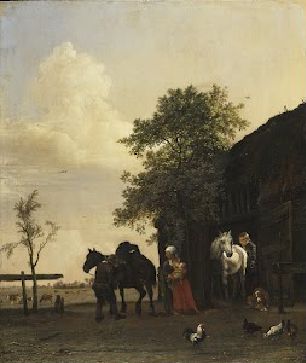
fig. 8 Figures with Horses by a Stable
Paulus Potter
1647
Oil on panel, 45 x 38 cm.
Museum of Art, Philadelphia
The widely held notion that Potter was a catalyst of the School of Delft dates back to Max Eisler's classic volume on painting in Delft, Alt-Delft (1923). Art historian Peter Sutton argues that "many of the characteristics we associate with 'Delft' painting—the informal naturalism, monumental repose and vertical painting format—are already evident in a work like Two Cows and a Bull of 1647, the way in which Potter places the animals against the brilliant blankness of a summer sky differs little from the practice of later Delft genre painters who set their figures against light-colored walls. Above all, it is Potter's sensitivity to the workings of natural light, to its silvery tonality and contre-jour effects, which marks him as an important precursor of De Hooch and his Delft colleagues."Peter C. Sutton, Pieter De Hoogh: Complete Edition (Oxford: Oxford University Press, 1980), 17. On the other hand, Walter Liedtke maintains that this is "quite a tall order for an artist" seeing that not only was the artist only twenty-five at the time (in 1650) but that the older Delft masters Van der Ast, Bramer, Palamedesz and Van Velsen had also created "convincing effects of space and light."Walter A. Liedtke, ed., Vermeer and the Delft School, ed. Walter Liedtke (New York: Metropolitan Museum of Art, 2001), 88.
The famous Dr. Nicolas Tulp (1593–1674), who spotted the young Rembrandt van Rijn's genius twenty years earlier, was impressed by Potter's civilized behavior and politeness. In 1652, he persuaded Potter to move to Amsterdam where he became Potter's mentor. The painting was highly admired in the eighteenth and nineteenth centuries; in the 1870s the French artist and critic Eugène Fromentin asserted confidently that it, Rembrandt's Night Watch, and his The Anatomy Lesson of Dr. Nicolaes Tulp were the three most famous paintings in the Netherlands.Eugène Fromentin, Les Maîtres d'autrefois (1876; trans. as "The Masters of Past Time," Phaidon, 1981), 117. The bull, a symbol of prosperity in Dutch culture and a frequent subject in Dutch Golden Age paintings, was often depicted alongside horses. In contrast, goats were typically used to represent Italy. . Livestock analysts have observed that the bull in the painting seems to be a composite, with various anatomical parts representing six different bulls of varying ages. The bull was a symbol of prosperity to the Dutch, hitherto overlooked in art, and apart from the horse was by far the most commonly shown animal in Dutch Golden Age painting; goats were used to indicate Italy. This is an enormous and famous portrait which was in the Prince William V Gallery collection that Napoleon took to Paris in 1795 and through a later treaty was returned twenty years later in 1815. Livestock analysts have noted from the depiction of the various parts of the bull's anatomy that it appears to be a composite of studies of six different animals from widely different ages.Seymour Slive, Dutch Painting, 1600–1800 (New Haven: Yale University Press, 1995), 208-210.
Potter's etchings show the same sensitivity as his oils. By the time Potter died of tuberculosis at 28, he had profoundly influenced the way animals are depicted in European art.
 fig. 9 The Young Bull
fig. 9 The Young BullPaulus Potter
1647
Oil on canvas, 235.5 x 339 cm.
Mauritshuis, The Hague
PAULUS POTTER IN HIGH-RESOLUTION
While viewing works of art in person is irreplaceable, today's high-resolution digital images offer a compelling alternative. These digital representations, which far surpass traditional printed images in both color and detail, offer a valid means for appreciating art. Below, you'll find a curated collection of high-quality digital images showcasing the paintings of Paulus Potter that are readily accessible online.
Piebald Horse (1650–1654)
http://www.google.com/culturalinstitute/asset-viewer/the-piebald-horse/sgEVxMuYmyuvLw?projectId=art-project
Figures with Horse by a Stable (1647)
http://www.google.com/culturalinstitute/asset-viewer/figures-with-horses-by-a-stable/1gERIRKAvSitPw?projectId=art-project
http://www.nationalgallery.org.uk/paintings/paulus-potter-cattle-and-sheep-in-a-stormy-landscap
- Peter C. Sutton, Pieter De Hoogh: Complete Edition, Oxford: Oxford University Press, 1980, 18.
- Christopher Brown, Carel Fabritius: Complete Edition, Cornell University Press, Ithaca, 1981.
- Peter C. Sutton, Pieter De Hoogh: Complete Edition, Oxford: Oxford University Press, 1980, 18.
- Peter C. Sutton, Pieter De Hoogh: Complete Edition, Oxford: Oxford University Press, 1980, 17.
- Walter A. Liedtke ed., exh. cat. Vermeer and the Delft School, ed. Walter Liedtke ed., New York: Metropolitan Museum of Art, 2001, 88.
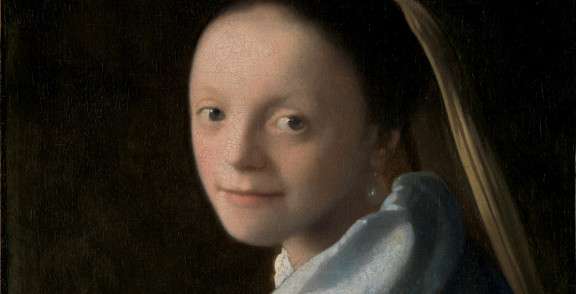
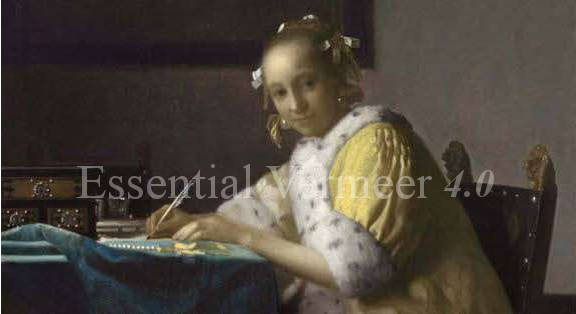


 or anything else that isn't working as it should be, I'd love to hear it! Please write me at:
or anything else that isn't working as it should be, I'd love to hear it! Please write me at: